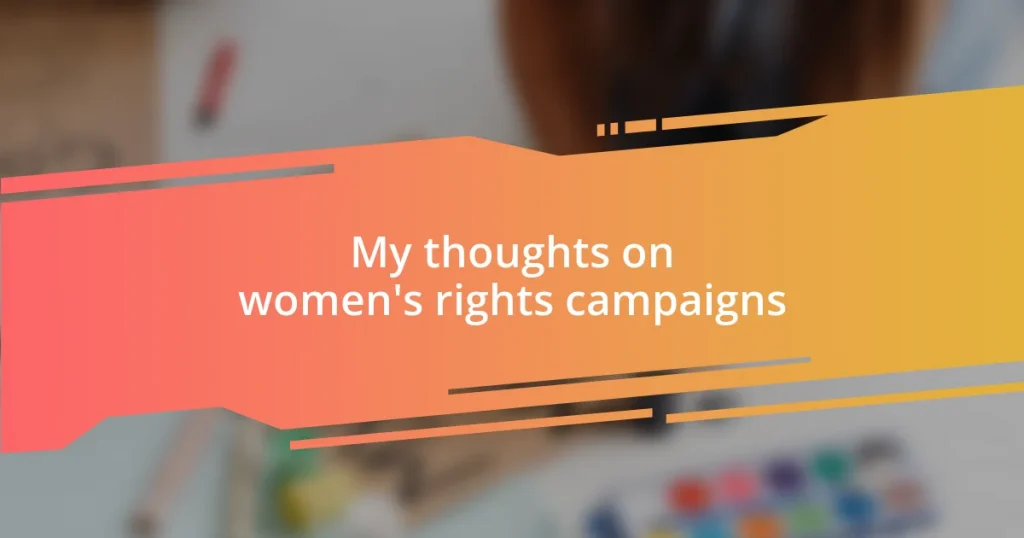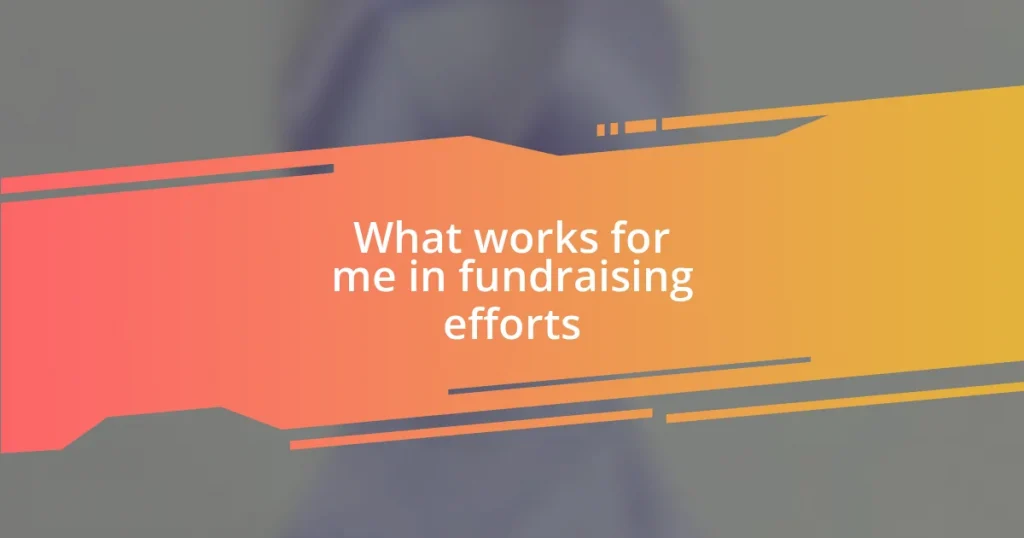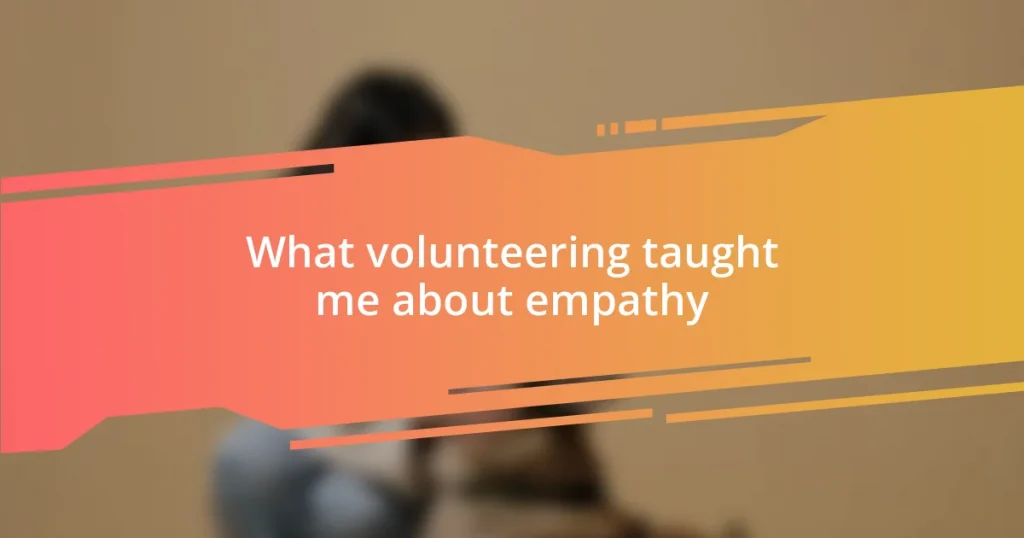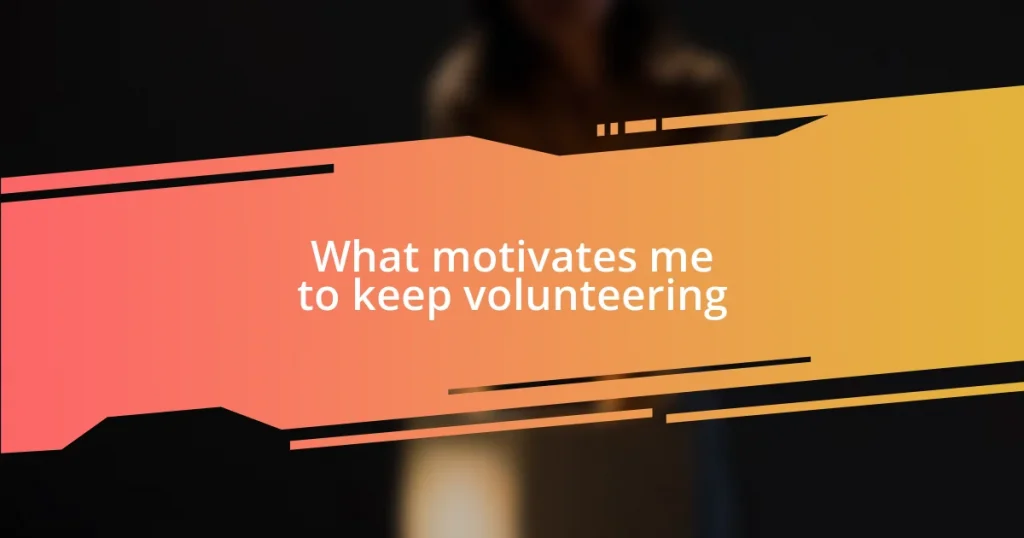Key takeaways:
- Women’s rights campaigns, from the suffragette movement to #MeToo, highlight the ongoing struggle for gender equality and the importance of collective action.
- Gender equality fosters social harmony, boosts economic growth, and empowers women, emphasizing the need for equal representation in decision-making roles.
- Effective advocacy requires relatable narratives, coalition-building across marginalized groups, and leveraging technology to engage a broader audience in support of women’s rights.

Overview of women’s rights campaigns
Women’s rights campaigns have emerged as pivotal movements advocating for gender equality and social justice globally. It’s incredible how these campaigns, like the suffragette movement in the early 20th century, set the stage for countless women to gain the right to vote, enabling them to voice their opinions and influence policy. I often think about how different our society would be without those brave women who stood for their rights despite facing immense opposition.
Over time, these efforts have evolved to address broader issues, including reproductive rights, workplace equality, and domestic violence. When I reflect on the #MeToo movement, it strikes me deeply how powerful collective voices can be in challenging societal norms—I sometimes wonder how many women felt empowered to speak out simply because they saw others doing the same. Such solidarity is a testament to the profound shift in our culture towards advocating for women’s experiences and rights.
These campaigns are not just historical milestones; they’re ongoing struggles reflecting the current battles women face today. It’s hard not to feel a rush of emotion when I witness the passion of activists who continue to fight against discrimination. Have you ever attended a rally or an event focused on women’s rights? Those moments, filled with hope and determination, remind us that the journey for equality is far from over, but the passion surrounding it is invigorating.
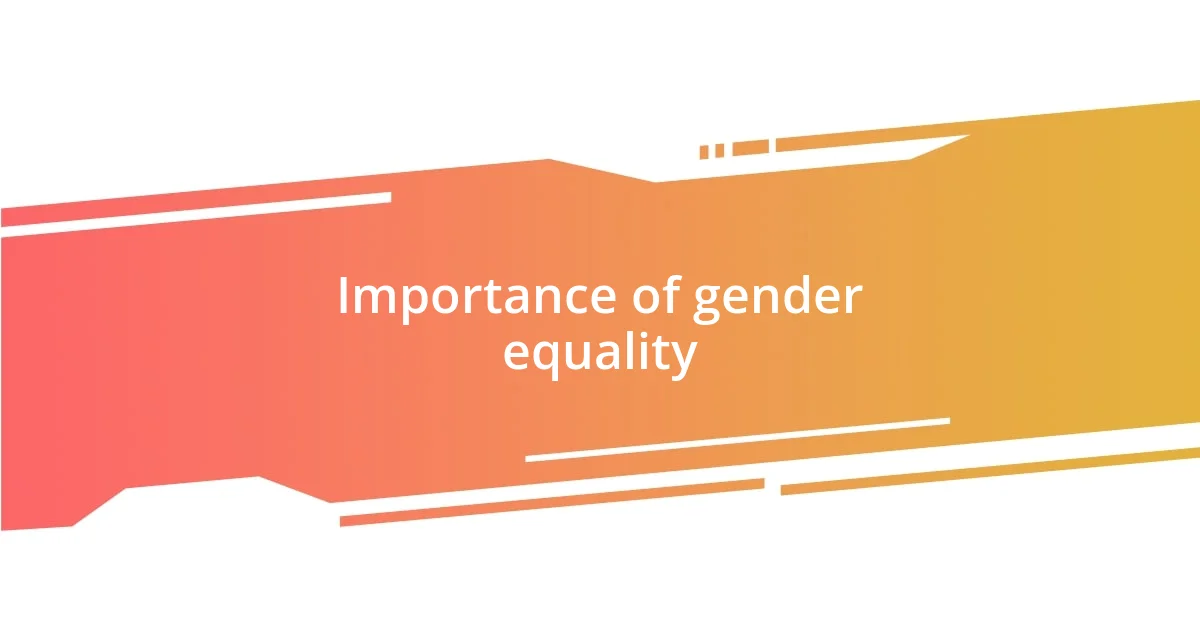
Importance of gender equality
Gender equality is crucial for a balanced and just society. When everyone has the same rights and opportunities, it fosters a sense of fairness that can lead to improved social harmony. I remember a conversation with a colleague who shared her struggles in pursuing a leadership role because of gender bias. It made me realize just how vital it is for women to have equal access and representation in decision-making positions.
Moreover, the economic benefits of gender equality are profound. Studies have shown that closing the gender gap in the workforce can significantly boost national economies. Thinking back on my own experiences, I’ve often seen diverse teams deliver more innovative solutions. It’s fascinating to think about how equality can both elevate women’s status and enhance overall productivity—something we all can appreciate.
On a more personal note, witnessing the progress in my community has been inspiring. Local initiatives aimed at empowering women have transformed lives and created a ripple effect. The joy and confidence I see in women as they step into roles they once thought unattainable is a testament to the importance of continual advocacy for gender equality. Doesn’t it remind you of the strength we all possess when given equal opportunities?
| Dimension | Impact of Gender Equality |
|---|---|
| Social Harmony | Promotes fairness and reduces conflict. |
| Economic Growth | Boosts productivity and motivates innovation. |
| Empowerment | Transforms lives and cultivates community role models. |
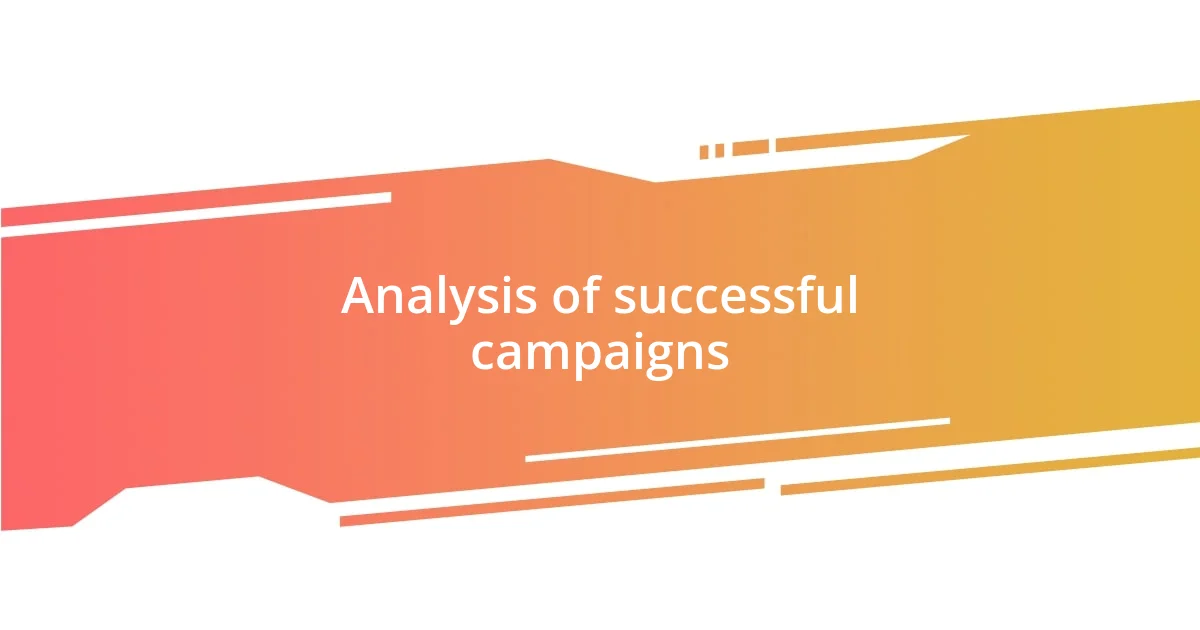
Analysis of successful campaigns
When examining successful women’s rights campaigns, I find it fascinating to see how strategies have transformed over the years. Take the Women’s March of 2017; it represented a remarkable global unity where millions rallied for a shared purpose. I remember seeing the sea of pink hats and feeling a palpable energy in the air, a sense of collective strength that was hard to ignore.
Successful campaigns often share common elements that resonate deeply with people. Here are a few:
- Clear Messaging: Campaigns like #MeToo utilized simple yet powerful slogans that were easy to understand and relay.
- Diverse Participation: A variety of voices—different ages, races, and backgrounds—enhanced credibility and reach.
- Engagement Through Social Media: Platforms like Twitter and Instagram allowed for rapid sharing of personal stories, connecting individuals worldwide.
I think it’s inspiring how these campaigns have adapted to changes in technology and culture, embracing the ways we communicate today. Each successful effort, from historical movements to contemporary initiatives, highlights the importance of evolution and innovation in advocacy.
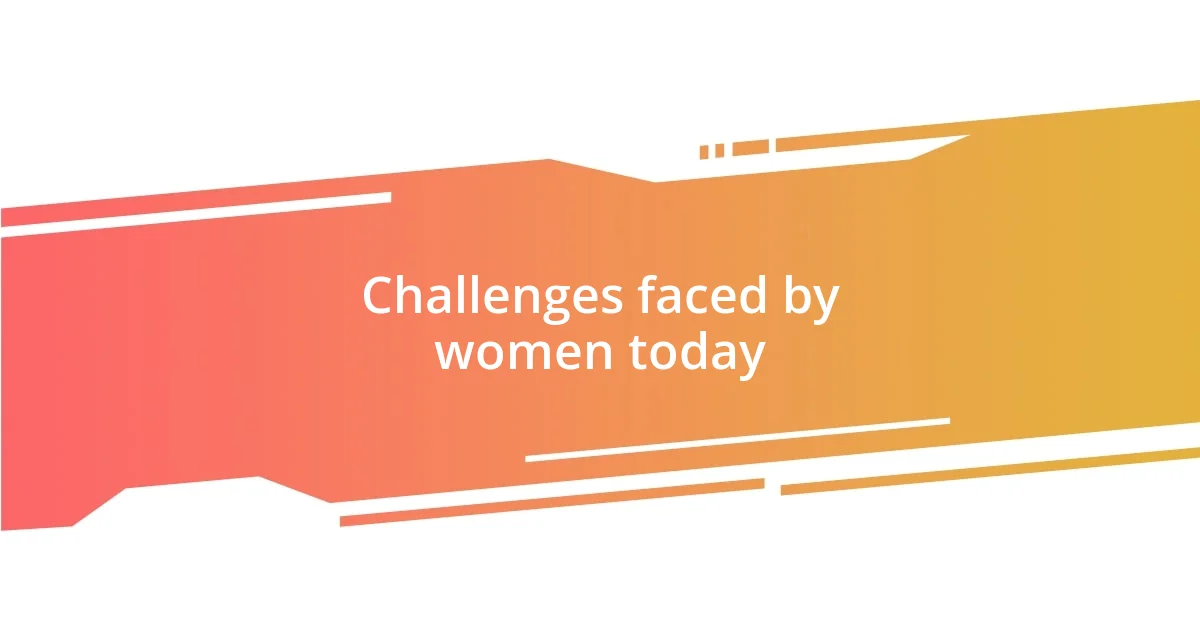
Challenges faced by women today
The challenges women face today are multifaceted and often interconnected. One significant issue is the pervasive gender pay gap, which affects many women across various industries. I find it disheartening to hear stories of friends who work tirelessly yet earn significantly less than their male counterparts for the same roles. It makes me wonder, how are we continuing to accept this as normal?
Another pressing concern is the ongoing struggle against gender-based violence, which remains alarmingly prevalent worldwide. I vividly recall a conversation with a close friend who shared her frightening experience of harassment while simply going for a jog. It struck me then how unsafe many women feel in everyday situations. This reality raises an important question: what can we do as a society to create safer spaces for women?
Access to healthcare and reproductive rights is also a challenge that cannot be overlooked. Many women encounter hurdles when seeking essential reproductive services, which can greatly impact their lives. I’ve often reflected on how vital these services are for a woman’s autonomy and well-being. It leads me to think: shouldn’t every woman have the right to make informed choices about her own body?
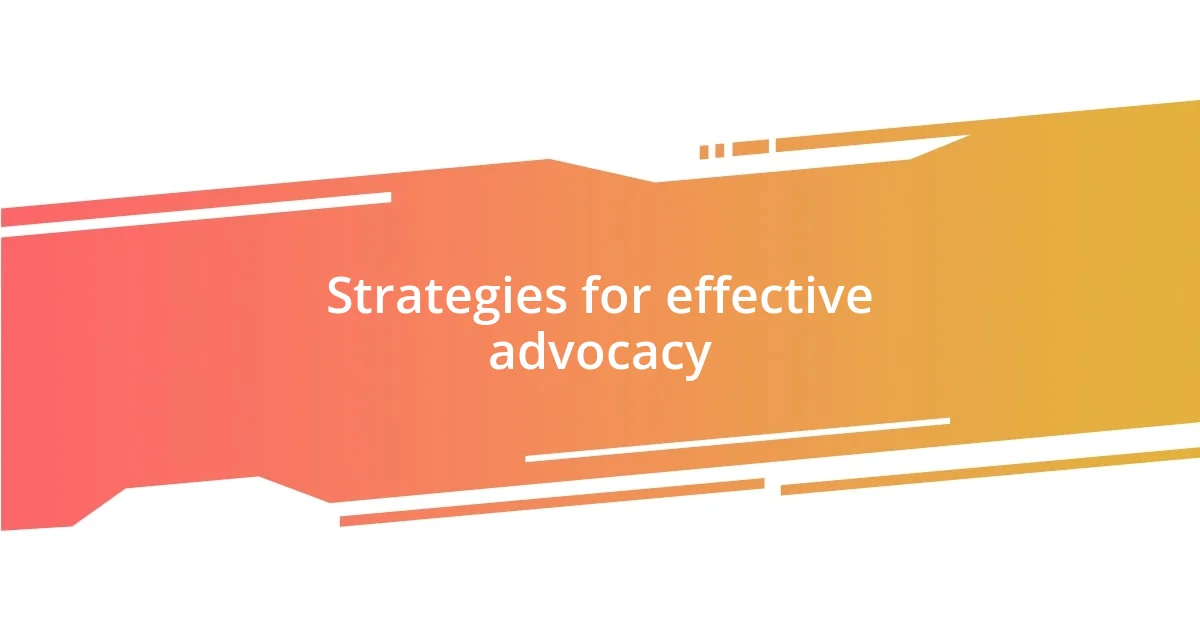
Strategies for effective advocacy
Effective advocacy hinges on the ability to craft relatable narratives that truly resonate with a diverse audience. I recall attending a local women’s rights workshop where a speaker shared her journey of overcoming obstacles related to workplace discrimination. Her story wasn’t just inspiring; it was a reminder of the power personal experiences can have in motivating others to join the cause. Have you ever wondered how a single story can shift perspectives? It can foster connections that statistics simply cannot.
Another vital strategy is building coalitions with other marginalized groups. When I participated in a community discussion that included voices from various backgrounds – including LGBTQ+ activists and Indigenous representatives – I felt a much richer dialogue unfold. This intersectionality not only amplifies our voices but also teaches us the nuances of each other’s struggles, ultimately leading to stronger collective action. Isn’t it fascinating how solidarity can enhance our advocacy?
Utilizing technology effectively is also crucial in today’s advocacy landscape. I’ve seen campaigns flourish simply by harnessing the power of social media. One memorable instance was when a friend organized a virtual panel discussing reproductive rights. The event attracted attendees from around the world, proving that geography shouldn’t limit our reach. It begs the question: how can we leverage these tools further to expand our impact and increase awareness? The possibilities are truly exciting.

How to support women’s rights
Supporting women’s rights goes beyond mere awareness; it’s about taking action in everyday life. One effective way is by participating in local advocacy groups or volunteering at organizations dedicated to this cause. I remember joining a women’s shelter for a weekend event, filled with the atmosphere of hope and resilience. The conversations I had with the women there were deeply moving, reminding me how our support can be the lifeline they desperately need. Isn’t it amazing how a few hours of your time can make such a transformative impact?
Another practical approach is integrating women’s rights advocacy into your daily conversations. I often find myself discussing gender equality with colleagues, whether during lunch breaks or team meetings. By normalizing these discussions, I feel we can all contribute to a culture that values women’s contributions and rights. If we don’t talk about these issues, how will we inspire change? It’s critical to challenge the status quo and create spaces where these topics can be explored openly.
Fundraising is also a tangible way to make a difference. I once organized a small charity event with friends, and we were pleasantly surprised by the turnout. The funds raised went to a local organization supporting survivors of domestic violence. It reinforced my belief that we can rally our communities together to elevate women’s issues. Have you thought about what you can do to mobilize those around you for this important cause? Every little effort counts, and collective action can yield meaningful results.










